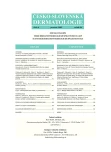Significance of Atopic Patch Test and Other Examination Methods in the Diagnosis of Peanut Allergy in Patients with Atopic Eczema Older than Fourteen Years. Significance of Pollen Allergy in This Patients’ Group
Authors:
J. Čelakovská 1; K. Ettlerová 2; K. Ettler 1; J. Vaněčková 1; J. Bukač 3
Authors‘ workplace:
Klinika nemocí kožních a pohlavních FN a LF UK Hradec Králové
přednosta doc. MUDr. Karel Ettler, CSc.
1; Ambulance klinické imunologie a alergologie, Hradec Králové
vedoucí MUDr. Květuše Ettlerová
2; Ústav lékařské biofyziky LF UK Hradec Králové
přednosta doc. Ing. Josef Hanuš, CSc.
3
Published in:
Čes-slov Derm, 84, 2009, No. 6, p. 332-340
Category:
Clinical and laboratory Research
Overview
The peanut allergy represents an increasing problem in Western countries. The at-risk subject is an atopic individual. The study performed in the period 2005–2009 evaluates the symptoms of atopic patients after peanut ingestion, the importance of atopy patch tests (and other methods) in the diagnostics of peanut allergy and the relation to pollen allergy in this patients group.
The most common symptoms described in atopic patients older than 14 years with atopic eczema included the oral allergy syndrom (17 %) and less common gastrointestinal and skin problems ( 2,8 %). Sensitivity of atopy patch tests to peanuts was 13,8 %, sensitivity of specific IgE antibodies and skin prick tests was 38,9 % and 47,2 %, respectively.
From 175 patients included in the study 46 (26 %) patients suffered from pollen allergy.
Our study confirmed the relation between the pollen allergy and the severity of symptoms after peanut ingestion. Atopic patients with convincing history of peanut allergy (oral allergy syndrom, gastrointestinal symptoms) suffered from pollen allergy in 33 %. The study demonstrates that atopic patients without anamnestical data of peanut allergy, but with positive specific IgE antibodies, skin prick tests or atopy patch tests suffer from pollen allergy in 64 %.
Our study did not confirm the importance of atopy patch tests in diagnostics of peanut allergy.
Key words:
atopic eczema – atopy patch tests – peanuts – pollen allergy
Sources
1. Bindslev-Jensen, C. Standardization of double-blind, placebo-controlled food challenges. Allergy, 2001, 56, p.75-77.
2. BREUER, K., HERATIZADEH, A., WULF, A. et.al Late eczematous reactions to food in children with atopic dermatitis. Clin Exp Allergy, 2004, 34, p.817 - 824.
3. Burks, AW., James, JM., Hiegel, A., Wilson, G., Wheeler, JG., Jones, SM., Zuerlein, N. Atopic dermatitis and food hypersenzitivity reactions. J Pediatr, 1998, p.132-136.
4. Crespo, JF., James, JM., Fernandez-Rodrigues, C., Rodrigues, J. Food allergy: nuts and tree nuts. Br J Nutr, 2008, 99(2), p.447-448.
5. Darsow, U., Laifaoui, J., Kerschenlohr, K., Wollenberg, A., Przybilla, B., Wüthrich, B., Borelli, S., Giusti, F., Seidenari, S., Drzimalla, K., Simon, D., Disch, R. The prevalence of positive reactions in the atopy patch test with aeroallergen and food allergens in subjects with atopic eczema: a European multicenter study. Allergy, 2004, 59(12), p.1318-1325.
6. ETTLER, K. Indexy v klinickém hodnocení psoriázy a atopického ekzému. Čs. Derm. 1995, 70(1), s.45-47.
7. Hand, S., Rolf, S., Stingl, C., jones, KP., Tonks, A. Rapid and accurate diagnosis of nut allergy. Skin prick testing in combination with serum IgE and clinical are adequate: A case control study. Allergy and Clinical Immunology International, 2004, 16(5), p.192-195.
8. Lee, LA., Burks, AW. New insights into diagnosis and treatment of peanut food allergy. Front Biosci, 2009,14 (1), p.3361-71.
9. Maloney J., Rudengren, M., Ahlstedt, S., Bock, SA., Sampson, HA. The use of serum-specific IgE measurement for the diagnosis of peanut, tree nut, and seed allergy. Journal of Allergy and Clinical Immunology, 2008, 122 (1), p.145-151.
10. Rancé, F., Kanny, G., Dutau, G., Moneret-Vautrin, DA. Food hypersenzitivity in children:clinical aspects and distribution of allergens. Pediatr Allergy Immunol, 1999,10, p.33-38.
11. Rancé, F., Dutau,G. Peanut hypersenzitivity in children. Pediatr Pulm, 1999, 18, p.165-167.
12. Rancé, F., Abbal, M., Lauwers-Cancés, V. Improved screening for peanut allergy by the combined use of skin prick tests and specific IgE assays. J Allergy Clin Immunol, 2002, 109, p.1027-1033.
13. ROGER, A., PENA, M., BOTEY, J., ESEVERRI, JL., MARIN, A. The prick test and specific IgE (RAST and MAST-CLA) compared with the oral challenge test with milk, eggs and nuts. J. Invest. Allergol. Clin. Immunol, 1994, 4, p.178-181.
14. Schaffer, T., Bohler, E., Ruhdorfer, S., Weigl, L., Wessner, D., Heinrich, J., Filipiak, B., Wichmann, HE., Ring, J. Epidemiology and food allergy/food intolerance in adults: association with other manifestations of atopy. Allergy, 2001, 56, p.1172-1179.
15. Schapppi, GF., Konrad, V., Imhof, D., Etter, K.,Wütrich, B. Hidden peanut allergens detected in various foods: findings and legal measures. Allergy, 2001, 56, p.1216-1220.
16. Seidenari, S., Giusti, F., Bertoni, L., Mantovani, L. Combined skin prick and patch testing enhaces identification of peanut-allergic patients with atopic dermatitis. Allergy, 2003, 58(6), p. 495-9.
17. Sicherer, SH. Clinical update on peanut allergy. Ann Allergy Asthma Immunol, 2002, 88(4), p.350-61.
18. Sporik, R., Hill, DJ., Hosking, CS. Specificity of allergen skin testing in predicting positive open food challenges to milk, egg and peanut in children. Clin Exp Allergy, 2000, 30, p.1540-1546.
19. ŠPIČÁK, V., PANZNER, P. Alergologie. 1. vyd. Praha: Galén, 2004
20. WERFEL, T., BALLMER-WEBER, B., EIGENMANN, PA., NIGGEMANN, B., RANCÉ, F., TURJANMAA, K., WORM, M. Eczematous reactions to food in atopic eczema: position paper of the EAACI and GA2LEN. Allergy, 2007, 62, p.723-728.
Labels
Dermatology & STDs Paediatric dermatology & STDsArticle was published in
Czech-Slovak Dermatology

2009 Issue 6
Most read in this issue
- Sarcoidosis
- Extraintestinal Form of Crohn’s Disease
- Analysis of Causes of Rising Syphilis Incidence in the Prague Population
- Contact Sensitivity to European Standard Series of Allergens
